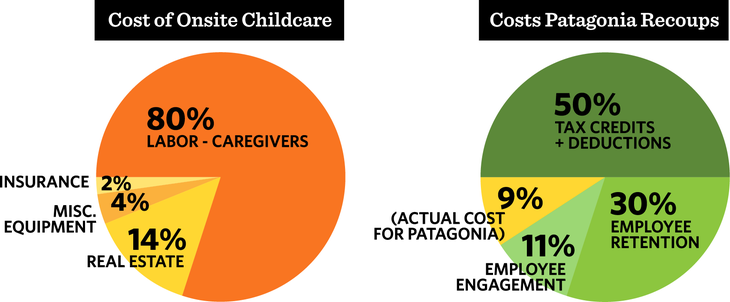For many new parents, attending Outdoor Retailer comes at a cost: leaving your kiddos behind. But, for Tessa Byars, the PR and communications manager at Patagonia, it was as easy as climbing into the cab of a truck.
“Our daughter was six months so my husband joined,” Byars recalled. “They adventured around Salt Lake and went to the Children’s Museum and climbed the hotel stairs hundreds of times. When she felt hungry, he would bring her by the Salt Palace and I’d use the Worn Wear truck cab in the booth as a nursing station.”
Byars credited Patagonia’s travel assist program for the easy transition. If an employee is traveling for work, the company will pay for a childcare professional (or parent) to travel with the employee. But not all working parents have such a generous employer policy.
Parenthood has seen a dynamic shift in the status quo over the past 50 years. Gone are the days where the majority of moms stay at home with the children. Instead, modern women like Byars have been opting to join the workforce, pulling double duty as both mother and employee.
In fact, the numbers are staggering: today, nearly 70 percent of mothers work, compared to less than half in 1975. And, fathers are chipping in on the parenting too. In the 1960s, stay-at-home dads were virtually unheard of, but now, nearly 7 percent of fathers take care of the children. Single parenting is also on the rise: 34 percent of children are now raised by a solo parent.

However, the U.S. childcare system has not evolved as quickly as our familial beliefs. With childcare costs around the country rising to nearly triple what they were in 1990 (surpassing the rate of inflation), recent data shows that infant care now exceeds the average four-year public college tuition in 33 states. For families living on a single minimum-wage salary, this means childcare costs nearly exceed their annual income.
Unfortunately, this comes at a time when women are becoming mothers later in life, so entry-level parents are farther along in their careers than a few decades ago. What this means: we’re losing experienced and qualified candidates because they are forced to choose between family and career.
Increase Employee Retention with Onsite Childcare
In its 36th year, Patagonia’s onsite childcare is a model worth replicating. The concept came about in 1983 when founder Malinda Chouinard parked a trailer with a babysitter in front of the building for employee, Jennifer Ridgeway. At the time, Chouinard was merely helping a friend, but the concept grew wings. The following year, a room in the back of the building replaced the trailer.
Today, the program at Patagonia’s headquarters in Ventura, California, has more than 150 children and offers an after-school program, in addition to the travel assist policy.
“It sounds like I’m bragging but the program is truly remarkable,” said Byars, who has two children in the program. “I’ve learned just about everything I know about parenting from the teachers who are experts in early childhood education.”
In 2017, the brand doubled down at its Reno distribution warehouse by opening the newly-expanded Truckee River Child Development Center. The warehouse employs more than 550 people. Thanks to Truckee River, all of the parents now have care for their children until they begin kindergarten.
Naturally, onsite childcare is a morally easy choice for employers. But, Patagonia’s data shows that it is financially logical, too.

According to Dean Carter, the vice president of human resources, the cost of onsite childcare at headquarters is roughly $1 million annually, after revenues (or tuition fees) are collected from families paying on a sliding scale based on local market value for full-time childcare. Patagonia evaluates each family’s household income to establish a fair tuition.
Of that amount, a whopping 91 percent is recouped through tax credits and deductions, employee retention, and employee engagement. This does not include intangibles like a trusting workplace culture or unsurpassed employee loyalty.
Other companies estimate that 25 to 35 percent of postpartum mothers never return to work, but Patagonia sees 100 percent retention in new moms. According to the company, turnover costs (lost productivity, training time, recruitment, and relocation) amount to 150 percent of a person’s base salary.
So ultimately it costs them roughly $90,000 a year to retain workers with families and increase morale.
“Family is very integrated into our workplace culture,” said Byars. “It’s fine if you need to leave a meeting to nurse or bring in your sleeping baby in a car seat. I’ve even worked countless hours from my car when my kids were little and fell asleep on the way to school. Everyone expects you to take care of your family first and knows that you will get your work done.”
And, even better: these recouping strategies apply to all business, large and small.
Small Business Solutions for Families
Of course, smaller businesses may not have the resources of larger companies like Patagonia, but there are still practical strategies employers of all sizes can utilize to support working parents.
- Increase flexibility. With stringent childcare hours and ever-shifting health needs for kiddos, a flexible schedule is one of the best benefits a business can offer a postpartum parent. Allowing employees to begin and end their work day early so they can make an afternoon doctor’s visit may not seem like much, but to the parent stressing about time management, that simple swap can mean everything.
- Offer parental leave. Providing more (or any) paid maternity leave is a godsend, but don’t forget about the fathers, too. Paternity leave gives families time to gel, but research shows that it also increases the strength of familial bonds over time. If ample parental leave is impossible for a small business, consider allowing part-time or work-from-home options to ease the transition back into the working world.
Above all else, remember that it takes a village. Companies that support working parents will receive invaluable employee loyalty, and that is a benefit that cannot be bought.
“Patagonia has made it so easy to integrate my work life and family life; I get to have the best of both worlds,” said Byars. “There is a reason we all come back to work after kids.”
What would your business look like with a 100 percent retention rate of parents?


